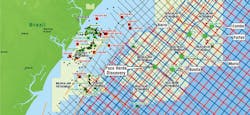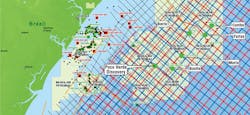Integrated dataset illuminates promising play extension in Brazil's Sergipe basin
Karyna Rodriguez • Mike Saunders•Neil Hodgson•Laurie Geiger
Spectrum Geo Ltd.
On the northeastern coast of Brazil lies the Sergipe basin, which in recent years has seen a rejuvenation in exploration effort and oil success. Onshore and shallow-water exploration here had a long history of delivering oil and gas discoveries. However, since 2010, Petrobras has made a series of off-shelf deeper water discoveries that have surprised and excited the industry. In that light, the location of blocks for the 14th Bidding Round in the acreage surrounding Petrobras’ discoveries leaves Sergipe poised to be the most prized acreage on the Brazilian margin.
The Barra discovery well was drilled in September 2010, reaching a depth of 6,510 m (21,358 ft) in 2,341 m (7,680 ft) of water. Permeability and porosity conditions in the reservoir are excellent at well depths of around 4,650 m to 4,750 m (15,256 ft to 15,584 ft), where drillstem tests indicate gas and condensate present in commercial quantities. The gross thickness of the zone of sandstones encountered in the Barra well is approximately 80 m (262 ft) thick from which well tests indicate a high porosity/low density, gas-charged reservoir. Other discoveries in the deepwater area of this basin include the Muriu and Farfan finds, with estimates indicating 3 Bbbl of oil in place and rising due to other exploration successes, including the latest Poço Verde discovery. These discoveries are in turbidite channel systems of mid-to late-Cretaceous and early Tertiary age. They are associated with clear amplitude anomalies on modern seismic, identification of which characteristic can significantly de-risk exploration. In fact, Petrobras has now submitted eight appraisal evaluation plans to the Brazil’s National Petroleum Agency to commercialize more than 3 Bbbl of reserves.
In 2014, Spectrum acquired 16,000 km (9,942 mi) of modern, long offset 2D seismic data over the Sergipe-Alagoas basin. The data was processed through pre-stack time migration using conventional techniques, and through pre-stack depth migration (PSDM) using both conventional and deghosting- bandwidth extension process techniques. The application of these technologies resulted in seismic data with a vertical resolution as fine as 5-10 m (16-32 ft), allowing identification of additional levels of interest which are mostly beyond seismic resolution in conventionally processed data. AVO stacks and attributes have been generated over the Sergipe sub-basin, and a targeted pre-processing flow was used to produce conditioned angle gathers calibrated with existing well data, indicating numerous potential AVO anomalies. Using the angle stack attribute (Far-Near*Far), it is possible to identify multiple undrilled amplitude and AVA anomalies, with similar character to the Barra trend, of similar and larger size and extending into open acreage and blocks in the current licensing round.
Recently, the gravity and magnetic data collected onboard the seismic vessel has been integrated with the seismic interpretation of a relatively clear Moho reflection on the PSDM sections, to produce a series of density models, and inverted to validate sedimentary thickness and crustal architecture, leading to improved heat flow prediction and thermal maturation profiles. This integrated study gives an extraordinary insight into the hydrocarbon systems working on this margin. In Sergipe, the Aptian source rock can be modeled with great control, so the oil-prone areas of the basin can be confidently mapped to lie under (and even beyond) the 14th round blocks. The integration of the seismic interpretation and derived seismic attributes with potential field data (gravity and magnetic data) has de-risked the petroleum systems.
To the northeast, primarily in the Alagoas basin, channel fill sediment plays, rifted basin fill, and faulted Palaeozoic sediments are the exploration targets. Yet in Sergipe, Spectrum can now demonstrate an extension of the successful channel system into the acreage to be offered in the upcoming bid round. The deepwater plays extend further outboard to the east and southeast where they have an added opportunity in a basin floor setting. The presence of ample sand entering the basin is confirmed by the channel discoveries to-date. On passive margins, these sand-filled channels are like gutters, bringing sand to the basin floor; they inevitably lead to vast sand deposits in deepwater. In Sergipe, these fans dip up to sea, where they must pinch out yielding low-risk traps of immense size. This is the true prize in the Sergipe basin. The evaluation suggests that the undrilled potential offshore Sergipe may surpass the discovered resources to date.
Integration of modern, high-quality seismic and potential field datasets has led to the confirmation of the extension into open acreage of proven turbidite channel systems of mid to late Cretaceous and early Tertiary age. Further offshore basin floor fans are associated with AVA anomalies similar to those of the discoveries.
Integration of available seismic and potential field data has resulted in a greater understanding of the main elements of the petroleum system and therefore, in the identification of multiple yet untested play types in this basin. The industry looks forward to the imminent 14th Bidding Round in Brazil, and Spectrum can fully expect Sergipe to offer the most sought-after prize.

